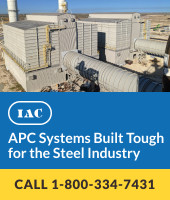Iron & Steel Technology

January Issue Now Online!
Steelmaking Technologies
Special Features Include:|
►steelStories From the World Steel Association (worldsteel): Bisley Gets Printing on Steel Down to a Fine Art |
Table of Contents
50
Advancing Electric Smelting for Sustainable Iron Production: Pilot-Scale Validation of Controlled Open-Arc DC Technology
The steel industry is undergoing a fundamental shift toward decarbonization, with direct reduced iron (DRI) smelting emerging as a critical component in achieving sustainable steelmaking. To support this transition, Metix Pty Ltd. has developed the Controlled Open-Arc (SOAC™) smelting process, designed for efficient and flexible processing of DRI in an electric furnace. This article outlines the structured development of SOAC, following the Technology Readiness Level (TRL) framework from initial concept (TRL 1) to pilot-scale validation (TRL 8). Two smelting campaigns were completed at pyrometallurgical pilot facilities: 200-kW test furnace processing 10 tons of DRI and nominally 1,000-kW demonstration test processing 370 tons of DRI. The results confirmed the high effi-ciency, metal recovery and adaptability of the SOAC process, with key benefits attributed to controlled arc length, optimized feed distribution and enhanced furnace stability. This work contributes to the broader green steel initia-tive, demonstrating the potential of open-arc smelting in a sustainable and scalable electric smelting process.
62
CMC Fires Up Texas One and Brings EAF Performance to the Next Level
In May 2020, CMC and Badische Stahl-Engineering (BSE) collaborated once more to upgrade the 123-ton* AC-electric arc furnace (EAF) in Seguin, Texas, USA. The primary goal of this significant upgrade was to enhance reliability and productivity. BSE customized key technologies for CMC Steel Texas, including a 21% increase in shell volume through gantry design. This upgrade aimed to reduce scrap leveling and provide greater flexibility in charge mixes. The project included a new EAF shell, tilt platform, electrode arms with slide-bearing gantry, trans-former delta closure, MultiROB and a hydraulic system. This article details the engineering of components using the finite network method and 3D component modeling, as well as the project management challenges encoun-tered during this multiyear endeavor.
76
Dynamic Heat Flow and Current Distribution Analysis in the Bottom Anode of an Electric Arc Furnace Using Fiber-Optic Sensors
A reliable method for monitoring bottom anode wear during direct current electric arc furnace (DC EAF) operation is of critical importance for safe and efficient steel production. Underestimation of bottom wear poses a serious safety risk that must be avoided, while overestimation of bottom wear also poses challenges, as premature anode replacement is expensive and affects EAF productivity. Previously, it was demonstrated that fiber-optic sensors can be successfully deployed to create a spatially distributed temperature map to monitor the health of the anode. The present work explores the heat flow and current density distribution in bottom anode pins to predict bottom wear and steel penetration events and monitor refractory erosion. Small dynamic variations in pin temperature induced by joule heating during arcing also provide a means to observe local current flows in each pin. When mapped, these measurements provide a real-time view of the nonuniform and dynamic current flow in the bottom anode during EAF operation that can affect bottom wear.
86
Optimization of Alloy Addition Timing During BOF Tapping: A Model for Establishing the Minimum Required Steel Level
Steel tapping from the basic oxygen furnace into the ladle is a pivotal stage in steelmaking, during which alloying materials are added to ensure rapid homogenization. This study addresses the challenges of alloy addition, par-ticularly the timing and its impact on ladle operations. Improper handling can damage the refractory lining and obstruct visual monitoring, while delayed additions reduce mixing efficiency and compromise process control. A mathematical model was developed to establish the required minimum steel level for a safe and efficient alloy addi-tion process, accounting for the movement of alloying material through the feeding pipe, freefall and immersion into the liquid steel in the ladle.


